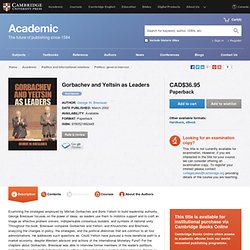

Facts about Human Evolution.
Gorbachev and Yeltsin as Leaders. Examining the strategies employed by Mikhail Gorbachev and Boris Yeltsin to build leadership authority, George Breslauer focuses on the power of ideas, as leaders use them to mobilize support and to craft an image as effective problem solvers, indispensable consensus builders, and symbols of national unity.

Throughout the book, Breslauer compares Gorbachev and Yeltsin, and Khrushchev and Brezhnev, analyzing the changes in policy, the strategies, and the political dilemmas that are common to all four administrations. He addresses such questions as: Could Yeltsin have pursued a more beneficial path to a market economy, despite Western advisors and actions of the International Monetary Fund?
For the chapters about Gorbachev, Breslauer was able to interview former members of the leader's politburo, including those who plotted Gorbachev's overthrow. Interested in how leaders make changes, Breslauer looks at how these leaders justified their actions and outflanked their opponents. What Happened Before History? Human Origins.
The Aztec Empire 1/5. Site de l'univers social au primaire » La société des incas et iroquoienne vers 1500. Projet partagé par Hélène Labranche – Commission scolaire des Hauts-Cantons Présentation projet Incas Jones Guide de l’enseignant Présentation sur les Incas Professeur Techno La carte de l’empire Incas Journal de bord de l’élève Pamphlet territoire final Corrigé activité 2 Corrigé activité 4 Corrigé éléments du territoire Points cardinaux: Est Nord Ouest Sud.

Un ado découvre une cité maya. William Gadoury, un adolescent de Saint-Jean-de-Matha dans Lanaudière, est devenu une petite vedette à la NASA, à l’Agence spatiale canadienne et à l’Agence spatiale japonaise, alors que sa découverte est sur le point d’être diffusée dans une revue scientifique. Passionné des Mayas depuis plusieurs années, il a analysé 22 constellations mayas et s’est aperçu que s’il reliait sur une carte les étoiles des constellations, la forme de chacune d’entre elles correspondait au positionnement de 117 cités mayas.
Aucun scientifique n’avait encore découvert une telle corrélation entre les étoiles et l’emplacement des villes mayas. Le génie de William a cependant été d’analyser une 23e constellation. Celle-ci contenait trois étoiles et seulement deux cités correspondaient sur la carte. Selon sa théorie, il aurait donc dû y avoir une 118e cité maya dans un endroit reculé et inaccessible dans la péninsule du Yucatan, au Mexique. Une des 5 plus grosses cités. 20 New Lines from The Epic of Gilgamesh Discovered in Iraq, Adding New Details to the Story.
The Epic of Gilgamesh, one of the oldest narratives in the world, got a surprise update last month when the Sulaymaniyah Museum in the Kurdistan region of Iraq announced that it had discovered 20 new lines of the Babylonian-Era poem of gods, mortals, and monsters.

Since the poem has existed in fragments since the 18th century BC, there has always been the possibility that more would turn up. The World Before Modern Times Assessing Background Knowledge. Water Animal Guide. Quick find...

Filter By: type diet region continent all Fish This combination might work, but unfortunately the animals with those characteristics don't live with us at the zoo. Bonnethead Shark Butterfly Fish Cownose Stingray Damsel Epaulette Shark Garden Eel Orbicular Batfish. 40 Fascinating Lectures for Linguistics Geeks. Maurya Empire. The Maurya Empire was a geographically extensive Iron Age historical power in ancient India, ruled by the Maurya dynasty from 322–185 BCE.

Originating from the kingdom of Magadha in the Indo-Gangetic Plain (modern Bihar, eastern Uttar Pradesh) in the eastern side of the Indian subcontinent, the empire had its capital city at Pataliputra (modern Patna).[1][2] The Empire was founded in 322 BCE by Chandragupta Maurya, who had overthrown the Nanda Dynasty and rapidly expanded his power westwards across central and western India, taking advantage of the disruptions of local powers in the wake of the withdrawal westward by Alexander's Hellenic armies. By 316 BCE the empire had fully occupied Northwestern India, defeating and conquering the satraps left by Alexander.[3] Chandragupta then defeated the invasion led by Seleucus I, a Macedonian general from Alexander's army, gaining additional territory west of the Indus River.[4] History[edit] Chandragupta Maurya and Chanakya[edit] Bindusara[edit]
Vedic period. Indus Valley Civilization. The major sites of the Indus Valley Civilization imposed over modern borders The Indus Valley Civilization (IVC) was a Bronze Age civilization (3300–1300 BCE; mature period 2600–1900 BCE) extending from what today is northeast Afghanistan to Pakistan and northwest India (see map).

Along with Ancient Egypt and Mesopotamia, it was one of three early civilizations of the Old World, and the most widespread among them, covering an area of 1.25 million km2.[3] It flourished in the basins of the Indus River, one of the major rivers of Asia, and the now dried up Sarasvati River,[4][5] which once coursed through northwest India and eastern Pakistan together with its tributaries flowed along a channel, presently identified as that of the Ghaggar-Hakra River on the basis of various scientific studies.[7][8][9] The Harappan language is not directly attested and its affiliation is uncertain since the Indus script is still undeciphered. Discovery and history of excavation. History of India in 10 minutes.
1947 - Roswell. Ancient egypt.